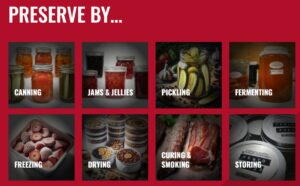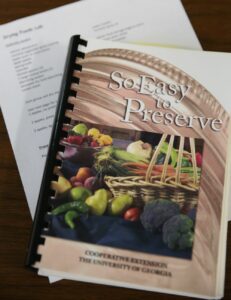Get Ready to Preserve Food
go.ncsu.edu/readext?1073334
en Español / em Português
El inglés es el idioma de control de esta página. En la medida en que haya algún conflicto entre la traducción al inglés y la traducción, el inglés prevalece.
Al hacer clic en el enlace de traducción se activa un servicio de traducción gratuito para convertir la página al español. Al igual que con cualquier traducción por Internet, la conversión no es sensible al contexto y puede que no traduzca el texto en su significado original. NC State Extension no garantiza la exactitud del texto traducido. Por favor, tenga en cuenta que algunas aplicaciones y/o servicios pueden no funcionar como se espera cuando se traducen.
Português
Inglês é o idioma de controle desta página. Na medida que haja algum conflito entre o texto original em Inglês e a tradução, o Inglês prevalece.
Ao clicar no link de tradução, um serviço gratuito de tradução será ativado para converter a página para o Português. Como em qualquer tradução pela internet, a conversão não é sensivel ao contexto e pode não ocorrer a tradução para o significado orginal. O serviço de Extensão da Carolina do Norte (NC State Extension) não garante a exatidão do texto traduzido. Por favor, observe que algumas funções ou serviços podem não funcionar como esperado após a tradução.
English
English is the controlling language of this page. To the extent there is any conflict between the English text and the translation, English controls.
Clicking on the translation link activates a free translation service to convert the page to Spanish. As with any Internet translation, the conversion is not context-sensitive and may not translate the text to its original meaning. NC State Extension does not guarantee the accuracy of the translated text. Please note that some applications and/or services may not function as expected when translated.
Collapse ▲If spring weather has inspired you to start a garden, you may also be thinking about what to do with your bounty later in the summer. If you’re planning to preserve foods this year, this is a good time to ensure you have the correct equipment and preserving instructions. We can help.
Food preservation recipes and techniques are constantly being studied and revised. Just because “you’ve always done it this way” or this is how your mother (or grandmother) taught you, you may not be using the most up-to- date methods. Also, just because you found a recipe on the internet or saw it on a cooking show does not make it SAFE. Please don’t take risks by not following tested and researched recipes and procedures.
 When answering questions about food preservation, I seek the assistance of several valuable resources. The National Center for Home Food Preservation is nationally recognized as a reliable and research-based source of food preservation information. Their website has a wealth of information and is available through the University of Georgia. They have added a BLOG to this website with up-to-date discussions about various methods of home food preservations.
When answering questions about food preservation, I seek the assistance of several valuable resources. The National Center for Home Food Preservation is nationally recognized as a reliable and research-based source of food preservation information. Their website has a wealth of information and is available through the University of Georgia. They have added a BLOG to this website with up-to-date discussions about various methods of home food preservations.
Another great reference is the latest (2015) edition of the United States Department of Agriculture’s (USDA) Complete Guide to Home Canning. This entire publication can be found online free-of-charge at the National Center for Home Food Preservation.
Sometimes I prefer a printed book. So Easy to Preserve (6th edition, 2015) is a recipe and instruction book from the University of Georgia’s Cooperative Extension. This beautiful book contains the latest recommendations for safe food preservation and lots of recipes. Many consider this to be the best reference available on the topic. If you like to own cookbooks, you can purchase it directly from their website at UGA for $35 (plus shipping). The book is 375 pages and has over 185 tested recipes and in-depth information for both the new and experienced preserver. SETP contains information of canning, pickling and sweet spreads, freezing and drying.
They also offer a children’s guide to preserving food. It’s called Preserve It & Serve It. This book is 47-pages that teaches the basics of preserving some foods with boiling water canning, freezing, refrigerating, quick pickling and drying. Step-by-step methods are illustrated and several child-friendly recipes are provided for using each of the preserved foods. Activities are intended to be carried out with adult supervision and help. Preserved foods include canned applesauce, canned strawberry jam, refrigerator or canned pickles, frozen berries, and dried fruit, tomato slices and applesauce rolled leather. It is $10 plus shipping.
 Another important task that should be done before canning season is making sure the gauge on your pressure canner is accurate. It is recommended that they be tested yearly. We offer this service free of charge. Pressure canners are essential when preserving all low acid foods such as vegetables, meat or fish. Don’t take the chance of losing all your hard work or preserving unsafe products due to an inaccurate gauge.
Another important task that should be done before canning season is making sure the gauge on your pressure canner is accurate. It is recommended that they be tested yearly. We offer this service free of charge. Pressure canners are essential when preserving all low acid foods such as vegetables, meat or fish. Don’t take the chance of losing all your hard work or preserving unsafe products due to an inaccurate gauge.
We’ll be testing canner gauges on Thursday, June 19th from 2:30 to 3:30 p.m. To have a gauge tested, bring the canner lid with the gauge attached to the Brunswick County Extension Center in Building N at the Government Center in Bolivia. It only takes a few minutes for the peace of mind knowing your gauge is accurate.
If this time is not good for you, drop your canner lid off at the Extension Center prior to the testing time and then pick up after the testing is completed. We will also test canner gauges by appointment throughout the summer. Just call and ask for Avery Ashley, our Family and Consumer Science Extension Agent. Please note: we are only able to test canners made by the Presto company and their associated brands. Weighted gauges do not need to be tested.
If you’re planning on doing some food preservation this year, you may want to consider entering it as an open class exhibit at the new Brunswick County Agricultural Fair and Expo that will be held in Ash, October 15th-19th. There will be categories for both youth and adults. More details on this will be available closer to the fair.
We also plan to offer food preservation classes later this summer. We’re thinking pickling, fermentation, jams & jellies, dehydrating and possibly pressure canning. Please give Avery Ashley a call at our office and let him know if there are specific topics in which you’d be interested.
Syracuse is a Family and Consumer Science team member and can be reached at N.C. Cooperative Extension, Brunswick County Center 910-253-2610 or by email at clsyracu@ncsu.edu




